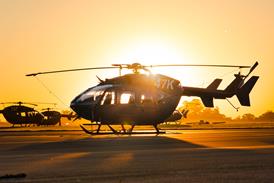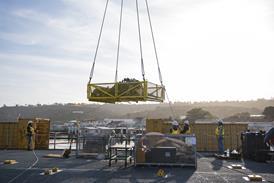
Andrew Doyle/LONDON
Airbus Industrie is discussing with airlines a plan to remove the thrust reversers from its A3XX ultra-high capacity airliner design as part of efforts to further reduce the aircraft's direct operating costs.
Airlines have generally reacted favourably towards the idea of dropping the system from the outboard engines only, but remain cautious over scrapping them altogether, say manufacturing sources.
"Current planning envisages having thrust reversers on just the two inboard engines, and the justification for that is that, through improvements in efficiency, we can achieve a stopping distance that is similar to existing four-engined aircraft such as the A340 and 747," says Airbus. "We are looking at whether we need thrust reversers at all but no decision has been taken," the consortium confirms.
Dropping the thrust reversers would save a significant amount of weight and reduce engine-associated maintenance costs, says British Aerospace Airbus director of engineering, Jeff Jupp. These benefits, he points out, have to be balanced against the increased brake wear that would occur during the landing run and the perceived safety implications.
"Airbus is putting the general question to the airlines to see what their views are," says Jupp. "It's a significant difference in weight - numbers of passengers for a given range is what we're talking about. As always with these things, to get the last 3-4% [improvement in direct operating costs] out you're looking at a package of measures." BAe Airbus builds the wings for all Airbus airliners, and is also responsible for the integration of the landing gear and engine installations.
Earlier this year, Airbus decided to delay the entry into service date of the A3XX by nine months, to late 2004, to give it more time to achieve the targeted 15-20% reduction on seat-kilomentre costs compared with the 747-400.
In September, French thrust-reverser specialist Hurel-Dubois announced it had signed a memorandum of understanding with Airbus to participate in the pre-launch phase of the A3XX programme. Thrust reversers are generally only used to reduce brake wear during landing, although their availability is required on some aircraft types under certain operating conditions. On the Boeing 747-400, for example, the availability of reverse thrust is not taken into account when take-off performance calculations are made for a dry runway. On a wet runway, however, it is assumed that two thrust reversers - ie, a symmetrical pair in the event of an engine failure - can be deployed.
For landing, reverse thrust is not taken into account unless brake performance is reported medium or poor, in which case reverse on three engines is assumed. On a "slippery" runway, landing is not permitted unless all four reversers are available.
Given the improved efficiency of the thrust-reversers on high-bypass ratio, big-fan engines such as those that would power the A3XX, most of the airlines consulted by Airbus are not objecting to including just two of the devices, on the inboard nacelles.
Source: Flight International























